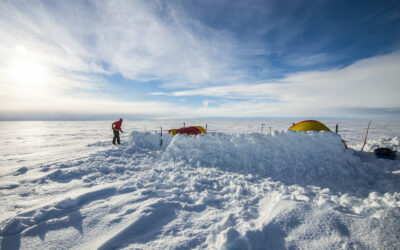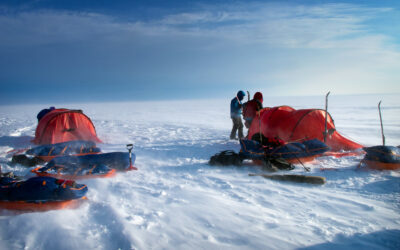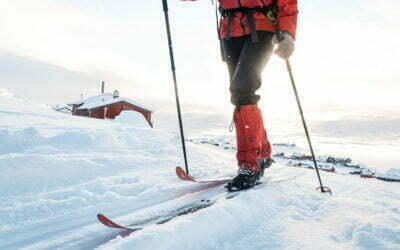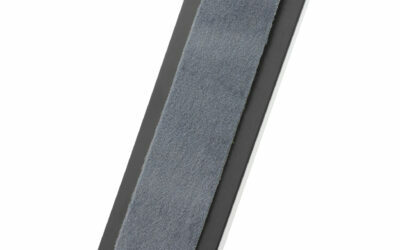Preparation
It’s vital to make sure that the dog has something to take shelter in – a dog-sized bivvy bag (“jervehi” or “jervenduk”), for example, or a sleeping bag. If the dog is to be outside, it should be wearing something to insulate it and protect it from moisture, rain, cold and injury.
In periods when the temperature’s extremely low, plan so that you’re not out when the cold’s at its worst. You can also shorten your expeditions on extra-cold days. In cold weather, you should always dress your dog in warm clothes – and, preferably, bring a rain jacket in case in case of rain, wet snow or sleet. There are also practical dog-suits that protect against both cold and frost and ice in the fur in winter. These are worth their weight in gold.
Furthermore, it’s good practice to avoid sudden changes in temperature. It is not best to bring an animal that’s been basking in front of the fire for hours straight right out into the cold – at least not without some form of clothing and protection. This applies to human animals, too! Even if we reduce the time we spend out in the cold, it still makes sense to make sure that the dog stays active. You can do this by activating the brain – searching for treats in the snow, or other activities that are fun for the both of you.

Whatever the weather, remember…
Before winter really sets in, and definitely before you set out on an expedition, consider taking your dog to the vet. Make sure all vaccinations are done and the dog’s in condition. Check for parasites. It’s essential that the dog’s protected against kennel cough: this can lead to far more serious problems. As a dog handler in the armed forces or in the police, you’re trained to do at least two daily checks on the dog. Hunters and other active dog people commonly do the same. This is strongly recommended.
Do this kind of check once in the morning and once in the evening, and after training on something specific. Go over the entire dog, starting from the muzzle and systematically checking the ears (give them a sniff), eyes, mouth, teeth and the rest of the body properly. Go over the paws, claws, footpads and legs. Runs the hands through the fur from head to tail and down the legs to feel for things in the fur – ticks and other nasties. Check the functioning of the joints, and the state of the genitals and the anus. Remember pulse and breathing, too.
Such a daily check, and follow-up care and treatment if its needed, will help enormously revealing issues and injuries before they develop into something more serious. As a general rule, keep an eye on he dog’s general condition.
As dog owners, we know our dogs best. We know how they usually behave. Perhaps your dog doesn’t come running to welcome you when you come home; perhaps its behaviour changes in another way; maybe it avoids you. This might be a sign of something possibly wrong.
Always remember to bring first aid for the dog
What should be included in a first aid kit for dogs? Read more about that here.

Fur
Dogs have fur. Luckily for them. This is the most important protection against weather, wind, and an unfriendly climate. Whatever you do wait until spring (or at least until you’re home for a spell) for grooming with the shaver. Grooming’s a good thing, though: get out the comb and pull out the tangles and dead hair. A well-groomed coat acts less like a Velcro fastener for bushes; it actually protects the dog better than lots of thick, unkempt fur.
Wet dogs
Be careful if your dog gets wet. Rain, snow and sleet can be trouble. Dirt and sand can get into the fur of many long-haired breeds when they get wet, causing tangles when it dries. You can protect a dog from the wet with the help of a rain jacket, snow suit, or a vest. After bathing and walks, cleaning and drying a dog is a pretty sensible move. The easiest way to get dirt from the fur is to get the dog in the shower, and then dry it. But this isn’t always possible out in the hills. Even if the dog doesn’t like it, you should use a hairdryer or dry them well with a towel or in a sleeping bag/ bivvy bag until they’re dry. This is to avoid the dog being wet for too long – essential for avoiding eczema or other skin problems. For all breeds and all kinds of fur, it’s important to dry between the toes and paws to avoid wet eczema.
Claws
This one’s tricky for many. We know. Many dog owners struggle with keeping paws clipped. The key here is basic “husbandry”. Google it, check out some YouTube videos or sign up for a course with a local club or veterinary clinic that offers a courses – you’ll be happy for the rest of your dog years for doing it and for keeping up the training. We promise!
Make sure to clip the claws regularly. If it becomes a habit for the dog, it’ll provide more opportunities to train the clipping and you can clip less at a time. By clipping little, more often, the nerves in the claws will retract and you minimize the risk of clipping too much and making things uncomfortable for the dog. When they’re too long, claws can get stuck in things, damage tents and sleeping bags. And in the worst case, they can put strain on the paws, even grow into the pads. No dog really likes long claws.
Paws
Speaking of paws, snow, slush and salt are a problem for active dog owners. They can cause cracks in the dog’s foot pads – and great discomfort for the dog. In winter, then, it’s doubly important to look after the paws. Winter can be really tough on sore paws. Hard crust, ice and frozen ground are particularly wearing on the footpads. Especially if you live in a place where the roads are salted; salt can create cracks in the paws. There are, of course, things we, as responsible dog owners, can do to make our four-legged friends more comfortable. If you’re observant, you can also spot problems early and do a lot to prevent them becoming more serious. A daily check of your dog’s paws and footpads is really recommended as part of a daily health check. If you walk on salted roads, it’s a good idea to rinse and dry the paws after you get back. Road salt can dry footpads out. If the salt gets into cracks in the paws, it can really sting. If your dog begins limping on a walk, it may well be salt finding a way into a wound.
Preventative protection
Well-kept dogs, as we’ve seen, are better equipped to withstand the elements. This also applies to the dog’s. Dogs with a lot of fur between their toes should have it groomed, cut and cleaned at regular intervals. Long fur on the paws, between the pads and toes, collects grass seeds, snow, salty ice, and dirt. And nothing is worse than paws full of grass seeds. Apart from paws and legs that have turned into lumps of ice. Groom the fur on the legs, on the paws and between the toes, so the paws dry faster and collect less dirt.
Paw socks
Wearing paw socks is a good move for a winter dog. They protect against both cold and salted roads. Paw socks rapidly find a place on the shopping list if you’re out skijoring, hunting, or hiking with a dog in the winter. We want to avoid cuts to a dog’s feet (and to the stomach and genitals, too). It can’t hurt to put grease or paw ointment on the paws before putting them in the paw socks – and keep an eye out to make sure the socks don’t fill with snow or ice while you’re out. Paw socks tend to fall off too, so it’s a good idea to take a few extra pairs. The long-distance socks are very good for hard use.

Greasing with paw salve
If your dog is susceptible to dry or cracked paws, this can both be prevented and treated with paw ointment. Ask your vet or visit a specialist shop to find something good; many pet shops carry good salves, and it’s a good thing to have in the pack if you have an active dog. Grease the paws for a while before you head out, preferably for several days in a row, so that the salve is absorbed properly into the paws while they’re still dry. And keep an eye on the dog – make sure it doesn’t munch the salve from its feet. This is where husbandry training and positive rewards come in.

Reflective doggo?
When it’s dark and cold outside, that doesn’t mean the end of physical activity. There’s the gym, for a start. Walking under the city lights can be an excellent alternative to venturing out in the dark. Dogs, however, need a good run out, and that’s maybe not so easy in the darker months – especially if you have a black dog. For dogs that are usually out in forests, fields and mountains, especially those used to running loose, treat them to a reflective vest or a little strobe. When hunting, it’s good practice to make the dog wear a conspicuous colour, for obvious reasons – and maybe it’s not such a bad idea to do the same in winter. Even in a well-lit street, a dark dog isn’t always obvious to a motorist. And in the darkest time of the year, both of you should wear a reflector if you’re walking together by the road. Out in the forest, in the mountains, and on the flats, meanwhile, a reflective doggo is the best kind. You know where it is and what it’s up to.

Insulate, insulate, insulate!
If you are reading this, you are human. When we go out overnighting in winter, we generally pack a bunch of clothes and a sleeping bag intended for temperatures colder than we expect: if we don’t equip ourselves properly, the worst case scenario can be genuinely dangerous. And this is how it should be for our dogs, too. They can’t read this, so make sure they have everything they need in the cold.
Sleeping bag
A sitting mat for the dog doesn’t take up much space in your pack, it weighs nothing, and dogs like them just as much as we do! If you plan to overnight, you should also bring a mat and a sleeping bag for the dog. The sleeping bag for the dog doesn’t have to be huge. It just has to big enough for your dog to turn around inside it. Surprisingly, choice is more limited than you’d expect, but we have good experience with two different bags: Nonstop Dogwear from Norway has a very nice sleeping bag called LY. Another option is Jerven’s classic Jervenduk.

Dog jackets
For humans, it’s always nice to pack a down jacket. Many of us never leave without an insulating jacket in the pack. Your dog can enjoy the same feeling of warmth and security too. Dog jackets are available in countless colours, editions, sizes and types. Some are made solely to provide warmth and protection from the cold, and others are made for hunting, for visibility, or to be waterproof. Find one of good quality right for what you want to do with your hound.
Harness
If you often have your dog in a harness, it’s crucial that it fits properly. If it doesn’t, it could lead to chafing and load in the wrong places. There are different types of harnesses for different uses, multi-use harnesses from one or two quality suppliers. Most harnesses are either intended for pulling, running or just walking, though – don’t bodge it!
A regular check up can prevent any chafing, discomfort or strain caused by a loose harness. Just as there’s a difference between harnesses made for different uses, dogs are physically different from breed to breed. Dogs that must pull on a harness must pull correctly. So its important that the harness fits your dog just right.
Life jacket
If you are going out in a boat and have to wear a life jacket yourself – get one for your dog. Eager dogs in a boat can fall overboard. And if they do, it’s just as important that they have a life jacket as it is for you. What’s more, you’ll be beyond glad for the handle on the life jacket: invaluable if the dog falls into the water and you have to lift it into the boat or onto the jetty.


Building a winter windbreak for you tent
To build a windbreak from snow, or not to build a windbreak from snow? This question comes up a lot. Here’s our advice – with a tip for those who’d rather not make the effort…

Setting up camp – essential routines
Preparation is, as always, everything. You can never be too well practiced and prepared. Take pitching a tent in strong winds, for instance. It’s something you can train for…

Storing skis until next season
Putting your skis to bed for the summer, clean and protected, is a chore, but it’s got to be done. It’s more than worth it. Here we break down the basics. Your skis will thank you. Actually, you’ll thank yourself come the first snow – for all sorts of reasons…

Boots for cross-country skiing in the backcountry
Nothing ruins the skiing experience as effectively as foot-related woe. Blisters. Wet socks. Sore arches. These things are the enemy. Good ski boots are incomparable – cherish yours once you’ve found them. Here’s a guide to help you find them.

Which cross-country skis? And how long?
Choosing new cross-country BC skis is can be bewildering. We compare length, width, profile. We weigh ourselves and check again. We ask advice on forums. We change our minds repeatedly. So before you pull the trigger, set your mind at rest by reading this overview. If you’re still unsure, you can talk to the expert in your local specialist shop or contact Åsnes’s customer service – we answer questions the whole time and we can usually help!

How to use Åsnes short skins
Wondering how to use Åsnes short skins? Not sure what these skins are good for and what the point is? Or wondering how to install a short skin? How to customize them? Whatever it is, here are the answers.